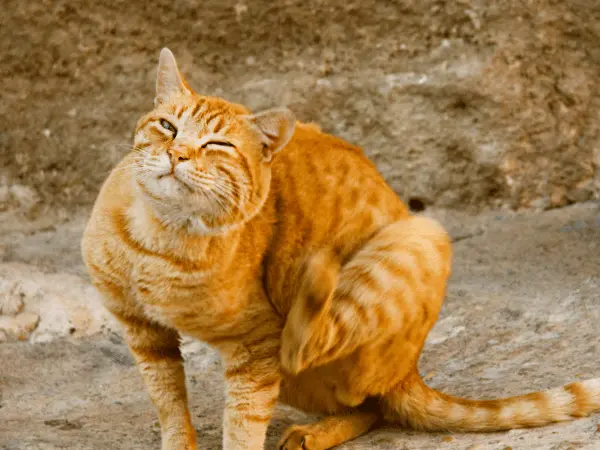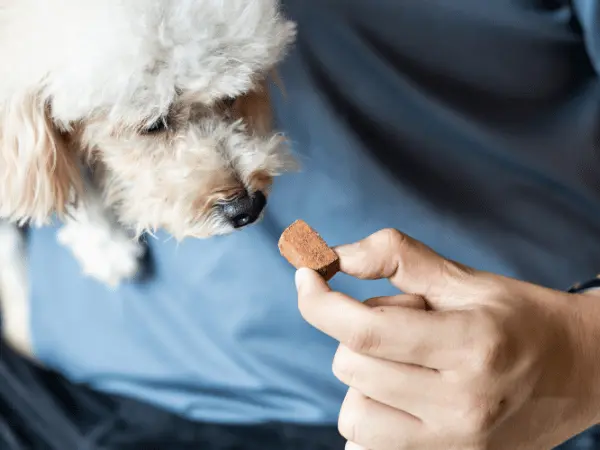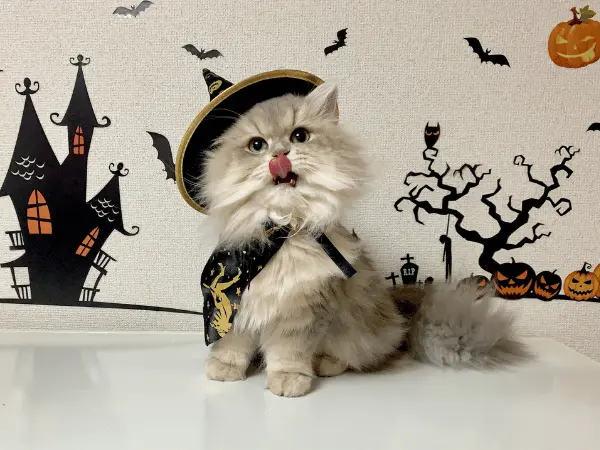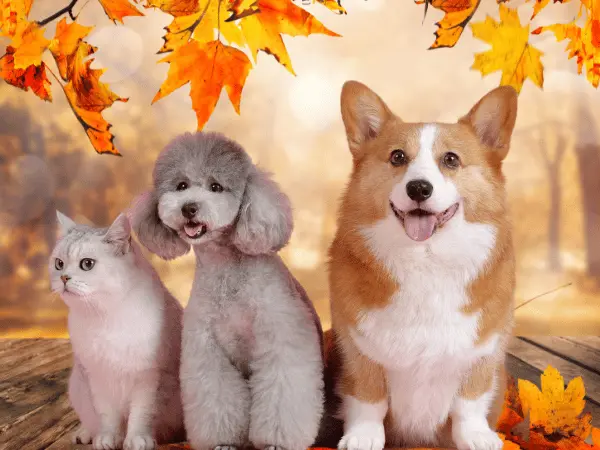As the warm summer days slowly transition into the autumn or fall season, the air is crisper, leaves change color, acorns abound, and festivities are all around. But what does this mean for your furry friend?
Here are useful autumn pet safety tips for dog and cat owners, prepared by Sploot Vets. Here, we talk about autumn pet risks — and how you can ensure your pet is safe, comfortable, and happy during this colorful season.
Autumn Pet Safety Tips – Dog & Cats
- Be Mindful of Leaf Piles
- Watch Out for Acorns
- Be Ready for Fleas & Ticks
- Prepare for Cold Weather
- Antifreeze & Ice Melt Pet Safety
- Relieve Fall Allergies in Dogs & Cats
- Don’t Forget Heartworm Preventatives!
- Seasonal Food Safety: Halloween Candy, Corn Cobs, & More
- Decor Safety: Candles, Cobwebs, & More
- Get Safe Halloween Costumes for Pets
- No Alcohol or Cannabis for Dogs & Cats
- Be Prepared for Pet Anxiety

1. Be Mindful of Leaf Piles
While it may be fun for pets to play in leaf piles, these can hide dangers like sharp sticks, broken glass, mold, and insects. Some dogs may also be prone to eating dried leaves, which is risky because moldy dried leaves can also cause digestive upset if ingested.
Lastly, damp piles might harbor disease-causing bacteria. To keep your pet safe, always supervise them when exploring leaf piles; it may be best to avoid old leaf piles altogether.
2. Watch Out for Acorns
Aside from dried leaves, there is another plant material that abounds during fall: acorns. Whether on the ground or part of a table centerpiece, acorns are a hazard. They contain tannins, which are toxic to dogs and cats if ingested in large amounts. Chewing on acorns can also pose a choking hazard or lead to intestinal blockages. It’s best to keep acorns out of reach for pets.
3. Be Ready for Fleas & Ticks
Fleas and ticks remain active during the fall; some species actually have their peak season during the early months of fall. Fallen leaves, old branches, and tall grass can be breeding grounds for these pests and they can latch on to your pet’s fur if they get close.
As an autumn pet safety tip, make sure to continue your flea and tick prevention routine. If you don’t have one yet, ask a trusted vet for recommendations! Also, regular grooming sessions and flea/tick inspections can help prevent infestations from worsening.
→ Learn more – How to Get Rid of Fleas & Ticks on Dogs & Cats

4. Prepare for Cold Weather
As the temperatures drop, it’s essential to ensure your pets stay warm and cozy. Make sure they aren’t left outdoors for extended periods, as cold weather can lead to hypothermia, especially in smaller pets and those with short fur. Providing warm bedding indoors is also recommended.
For older pets, cold weather can exacerbate joint pain and stiffness. Talk about joint supplements for dogs and cats with your vet; these contain ingredients like glucosamine or omega-3 fatty acids to support mobility and promote comfort, especially during the colder months.
5. Antifreeze & Ice Melt Pet Safety
Antifreeze and ice melts are two chemicals that pose risks to pets during autumn.
As temperatures drop, an engine’s seals and hoses can contract, making antifreeze leaks more common. This substance is highly toxic to dogs and cats and its sweet taste can attract curious pets. (Even antifreeze with bitter additives can still be attractive to some pets.)
Unfortunately, just a small amount of antifreeze can lead to severe kidney damage or death. This is why it’s recommended to keep dogs and cats away from the car or any source of antifreeze spills.
Additionally, commercial ice melts, which are used on sidewalks at the season’s first snow, may irritate or chemically burn your pet’s paws. As an autumn pet safety tip, always wipe your pet’s paws after walks or time outdoors. For dog owners, you can also use paw balm or dog shoes to protect their feet during walks.
6. Relieve Fall Allergies in Dogs & Cats
Dogs and cats can also suffer from fall allergies, triggered by pollen, mold spores, and dust mites. Watch for symptoms like excessive shedding, itching, wheezing, coughing, nasal/eye discharge, or recurring ear infections. If you notice any of these symptoms, talk to your vet about managing allergies in dogs and cats.
→ Learn more – Signs of Fall Allergies in Dogs & Cats & What to Do Next
7. Don’t Forget Heartworm Preventatives!
While heartworm in dogs and cats is often associated with warm weather, it’s important to continue prevention year-round. Mosquitoes can still be active in the fall, potentially carrying heartworm larvae. This is why it’s important to keep up with your pet’s preventative heartworm medication to avoid any lapses in protection.
→ Learn more – Heartworm in Dogs & Cats: Cause, Prevention & More [Vet-Approved]

8. Seasonal Food Safety: Halloween Candy, Corn Cobs, & More
Fall festivities mean more sweets and treats around the house, but some of these are dangerous for pets. Chocolate and candy with xylitol are toxic for pets — so make sure to keep Halloween candy securly stored!
→ Learn more – What to Do If Your Dog or Cat Eats Halloween Candy [Ask a Vet]
Corn cobs are also potentially harmful to pets and can cause anything from digestive upset to choking. High-fat food can also trigger pancreatitis in dogs and cats, whether acute or chronic. As an autumn pet safety tip, it’s best to keep all seasonal foods out of reach, and monitor your pet during celebrations. If you’re like to include your dog or cat during gatherings, you can prepare their own delicious home-made treats:
- → Learn more – Top 10 Healthiest Human Foods That Dogs Can Eat
- → Learn more – Top 10 Healthiest Human Foods That Cats Can Eat
9. Decor Safety: Candles, Cobwebs, & More
Seasonal decorations during autumn, such as candles, string lights, and faux cobwebs can pose risks to curious pets. Cats may be tempted to play with dangling cobwebs and string lights, while dogs might knock over lit candles or chew on cords.
As much as possible, use pet-safe autumn decor; here are a few tips:
- Replace real candles with electric candles
- Do NOT leave Jack-O-Lanterns unsupervised
- Use battery-operated string lights to prevent chewing on the cord
- Have a secure cover on all candy or treat bowls
- Don’t leave decorations with acorns lying around
10. Get Safe Halloween Costumes for Pets
If you plan to dress up your pet for Halloween, ensure that the costume fits well and doesn’t restrict their movement, vision, or breathing. AVOID costumes with small parts that could be chewed off and swallowed. Always supervise your pet while they’re in costume to prevent stress or injury.

11. No Alcohol & Cannabis for Dogs & Cats
Holiday gatherings often include alcoholic beverages, which are toxic to pets. Even small amounts of alcohol can cause vomiting, diarrhea, and tremors in dogs and cats. Therefore, as an autumn pet safety tip, keep alcoholic beverages away from your pets and be mindful of spills.
Another recreational indulgence to be mindful of is cannabis. As its usage becomes more popular, especially in social gatherings, pet parents should be aware that cannabis is toxic to pets, whether ingested or inhaled. Exposure can lead to symptoms like agitation, loss of coordination, urinary incontinence, and disorientation. In large amounts, it can even result in marijuana poisoning, which may lead to comatose. We advise pet parents to keep dogs and cats away from marijuana or cannabis products/smoke.
12. Be Prepared for Pet Anxiety
Festivities like Halloween and Thanksgiving can overwhelm pets with loud noises, visitors, and constant doorbell rings. Therefore, we recommend pet parents set up a quiet space where a dog or cat can retreat during these events. Fill the space with familiar toys and comfortable bedding. This safe space for your pet should be somewhere where they won’t be bothered. In line with this, make sure that windows are closed to prevent your pet from running away.
On the other hand, if you’re boarding your pet while traveling for Thanksgiving, you can help ease your pet’s separation anxiety with familiar items, their favorite food, and calming aids like pheromone diffusers.
→ Learn more – Pet Boarding Essentials to Pack for Your Fur Baby
Note: If your pet is suffering from severe anxiety, you can talk to your vet about prescription medication for pet anxiety that can be used on an as-needed basis.
Final Thoughts on Autumn Pet Safety Tips for Dogs & Cats
This wraps up our autumn pet safety tips for dog and cat owners. We trust that you found this guide helpful in preparing your pet for fall. If you have further questions about your fur baby’s health, we’re here for you!
Sploot Veterinary Care is a Fear Free vet clinic in Denver and Chicago, offering next-level vet care and convenient availability 365 days a year. Visit us during our extended clinic hours for primary, urgent, or emergency vet services.
Book an appointment online or call us for urgent concerns. Till next time we’re with you every pounce of the way!
